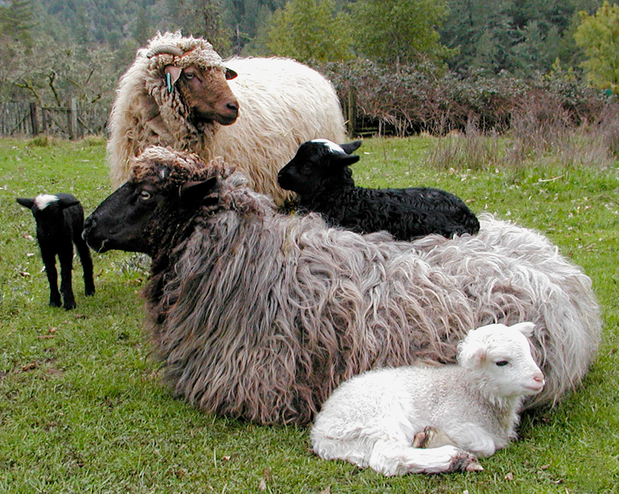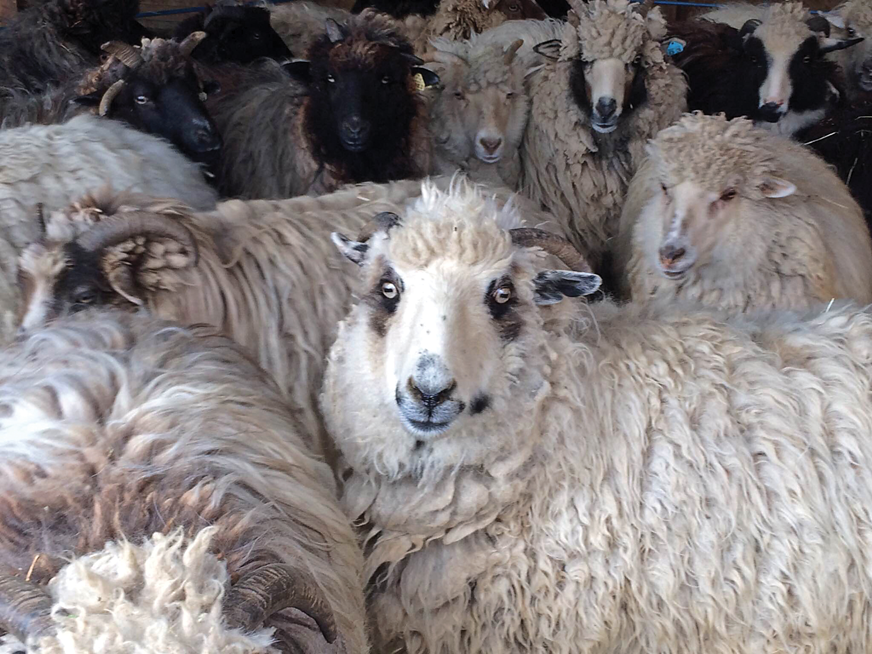Art and Legacy of the Navajo-Churro Sheep
THE NAVAJO-CHURRO SHEEP
A Rich History with an Artistic Legacy
A Rich History with an Artistic Legacy
The Navajo-Churro lineage was introduced to the Southwest by the early Spanish colonizers. (The Spanish name for the sheep, Churra, was changed to Churro by American settlers.) The first Churro sheep were brought over by the Spanish explorer Coronado in 1540. The lineage did not become well established in the Southwest until, in 1598, Don Juan de Onate brought a flock of slightly less than 3000 Churro sheep into New Mexico from Mexico via present day El Paso.
The Churro were well suited for the harsh environment of the Southwest. They soon became important to the Spanish and Pueblo cultures in the Upper Rio Grande Valley. To the west of the Upper Rio Grande Valley was the indigenous culture of the Diné (Navajo). The Diné, through interaction with the people in the Pueblos and trade with the Spanish, acquired the Churro sheep in the 1650’s. The Diné began weaving with the Churro wool on vertical looms like those in the Pueblos, and this adaptation redirected the cultural development of the Diné over the next three centuries.
The meat, wool, and woven goods from the wool of the Churro sheep became an important part of the economic life of the Spanish Colonial Period. As the Southwest developed, woven textiles using the wool of the Churro, especially those from the Dine, became highly prized commodities important for trade well into the New Mexico Territorial Period. Although the woven textiles were for a range of utilitarian uses, they established a rich artistic and cultural legacy in woven wool textiles that is ongoing today.
A series of historical events in the Southwest in the 19th century led to the decline of the Navajo-Churro sheep. Native ranchers maintained small family flocks in the canyons and rough grazing lands but formal restoration of the breed did not begin until the 1970s when breeders began acquiring Churro phenotypes with the purpose of preserving the breed and revitalizing Diné and Hispanic flocks. Today, the Navajo-Churro is a heritage sheep breed.
Navajo-Churro are quite rare in that they have a double-coated fleece. The fleece consists of an inner, finer fiber and a longer, coarser outer coat that sheds the rain, dust, snow and protects the sheep. The inner fibers give yarn or felt loft, and the outer fibers add strength. Wool fibers have scales. These scales make wool fibers interlock, which makes wool fibers excellent for spinning into yarn or felting. The Navajo-Churro sheep produce wool in a range of colors - pure white, cream, gray, light or dark brown, and pure black.
The sheep can be shorn twice a year. Processing the fleece from the sheep to produce material suitable for spinning or felting involves several steps. The first step is called skirting, which is the removal by hand of extraneous material such as twigs, leaves, grass fragments, etc. The skirted material is then washed in water at 160o F to remove oils on the fibers. The washing is followed by two rinses using water at 160o F. After the washed and rinsed material is carefully dried, it is carded. The carding produces lofted layers of wool material with loosely entangled fibers.
For an excellent look at the richness of the history of the Navajo-Churro sheep and its complex intertwining with key events in the history of the Southwest, we recommend Spanish Textile Tradition of New Mexico and Colorado, Museum of New Mexico Press, Santa Fe, NM, 1979.
Today, people like the artist Minna White (whose work is on display in this show as Lana Dura LLC) are preserving the beauty and variety of the Navajo-Churro sheep wool and enhancing the artistic traditions associated with wool worldwide.
The wool Ms. White uses comes directly from her flock and others in North America.
Wool fibers have scales which makes the material interlock which is excellent for spinning into yarn or felting. The wide variety of natural Navajo-Churro colors range from pure white, cream, gray, light or dark brown all the way to pure black.
The Churro were well suited for the harsh environment of the Southwest. They soon became important to the Spanish and Pueblo cultures in the Upper Rio Grande Valley. To the west of the Upper Rio Grande Valley was the indigenous culture of the Diné (Navajo). The Diné, through interaction with the people in the Pueblos and trade with the Spanish, acquired the Churro sheep in the 1650’s. The Diné began weaving with the Churro wool on vertical looms like those in the Pueblos, and this adaptation redirected the cultural development of the Diné over the next three centuries.
The meat, wool, and woven goods from the wool of the Churro sheep became an important part of the economic life of the Spanish Colonial Period. As the Southwest developed, woven textiles using the wool of the Churro, especially those from the Dine, became highly prized commodities important for trade well into the New Mexico Territorial Period. Although the woven textiles were for a range of utilitarian uses, they established a rich artistic and cultural legacy in woven wool textiles that is ongoing today.
A series of historical events in the Southwest in the 19th century led to the decline of the Navajo-Churro sheep. Native ranchers maintained small family flocks in the canyons and rough grazing lands but formal restoration of the breed did not begin until the 1970s when breeders began acquiring Churro phenotypes with the purpose of preserving the breed and revitalizing Diné and Hispanic flocks. Today, the Navajo-Churro is a heritage sheep breed.
Navajo-Churro are quite rare in that they have a double-coated fleece. The fleece consists of an inner, finer fiber and a longer, coarser outer coat that sheds the rain, dust, snow and protects the sheep. The inner fibers give yarn or felt loft, and the outer fibers add strength. Wool fibers have scales. These scales make wool fibers interlock, which makes wool fibers excellent for spinning into yarn or felting. The Navajo-Churro sheep produce wool in a range of colors - pure white, cream, gray, light or dark brown, and pure black.
The sheep can be shorn twice a year. Processing the fleece from the sheep to produce material suitable for spinning or felting involves several steps. The first step is called skirting, which is the removal by hand of extraneous material such as twigs, leaves, grass fragments, etc. The skirted material is then washed in water at 160o F to remove oils on the fibers. The washing is followed by two rinses using water at 160o F. After the washed and rinsed material is carefully dried, it is carded. The carding produces lofted layers of wool material with loosely entangled fibers.
For an excellent look at the richness of the history of the Navajo-Churro sheep and its complex intertwining with key events in the history of the Southwest, we recommend Spanish Textile Tradition of New Mexico and Colorado, Museum of New Mexico Press, Santa Fe, NM, 1979.
Today, people like the artist Minna White (whose work is on display in this show as Lana Dura LLC) are preserving the beauty and variety of the Navajo-Churro sheep wool and enhancing the artistic traditions associated with wool worldwide.
The wool Ms. White uses comes directly from her flock and others in North America.
Wool fibers have scales which makes the material interlock which is excellent for spinning into yarn or felting. The wide variety of natural Navajo-Churro colors range from pure white, cream, gray, light or dark brown all the way to pure black.
*******



